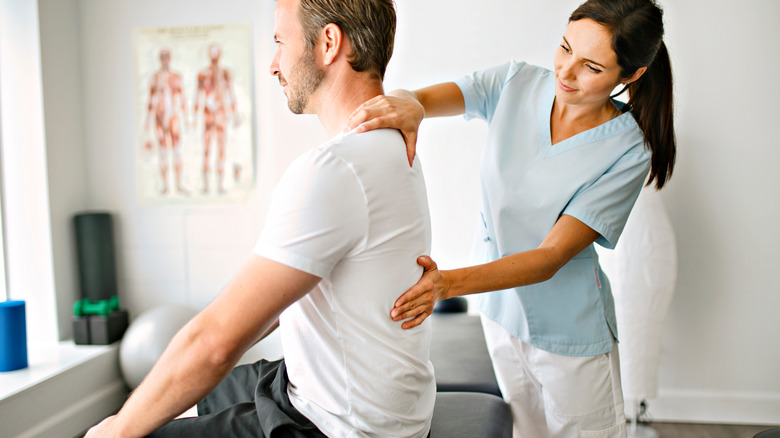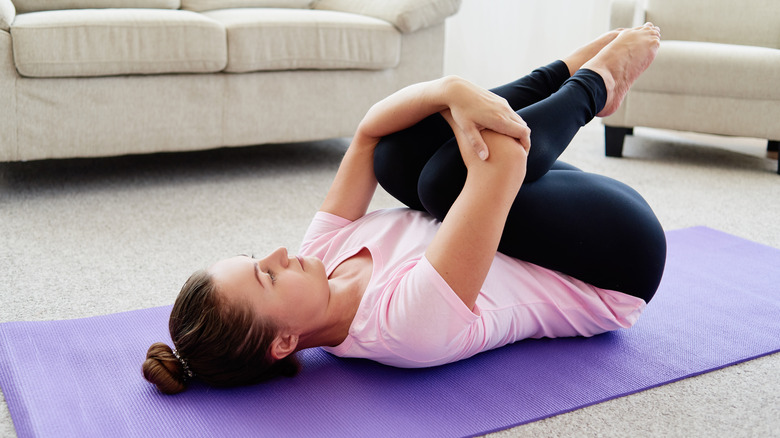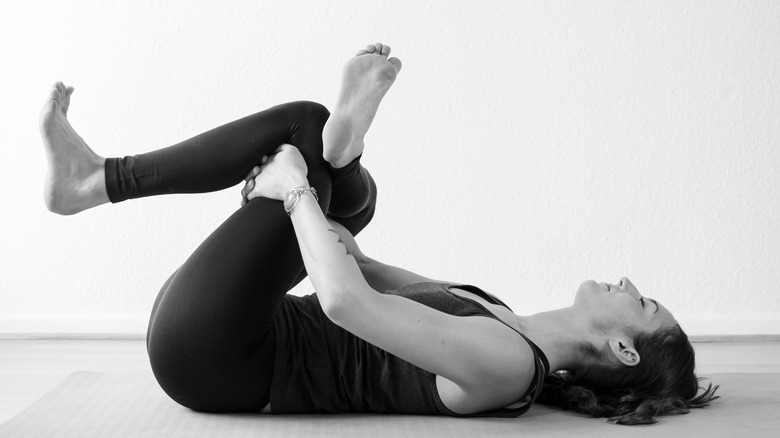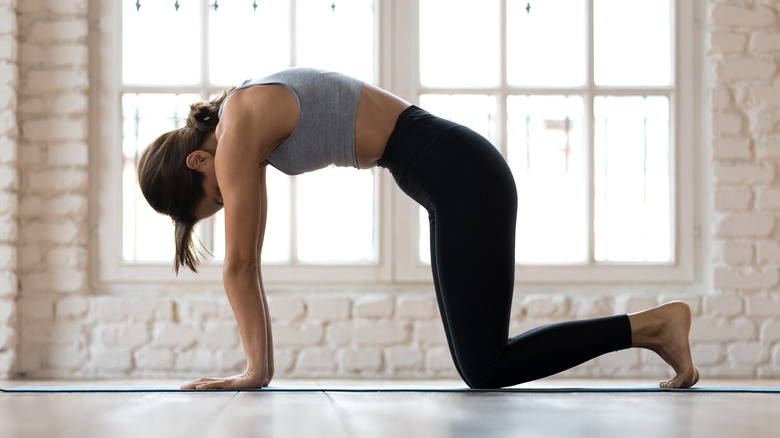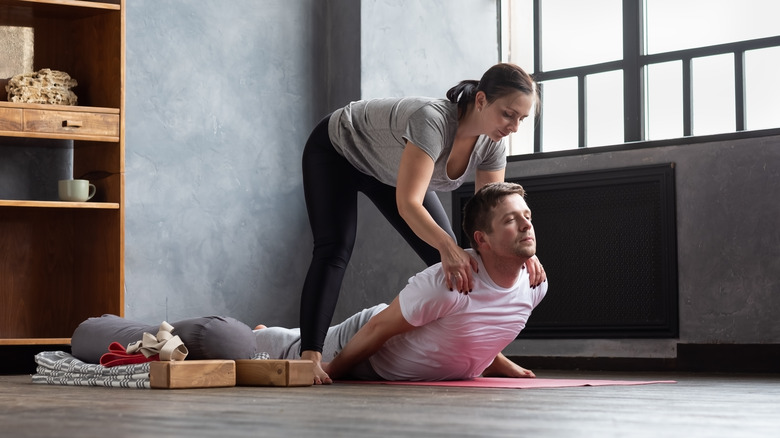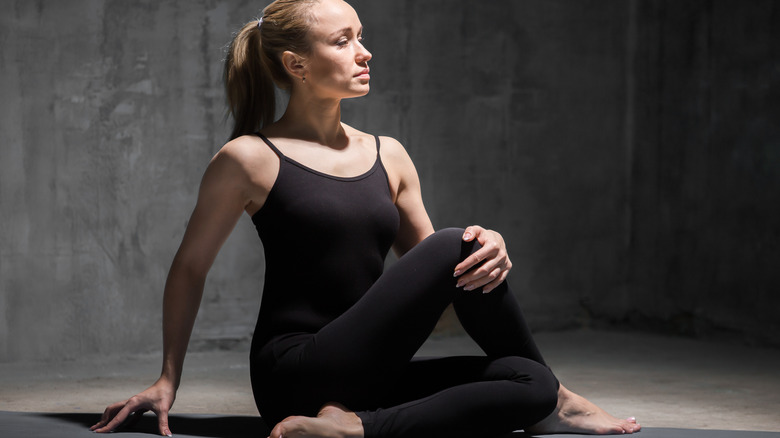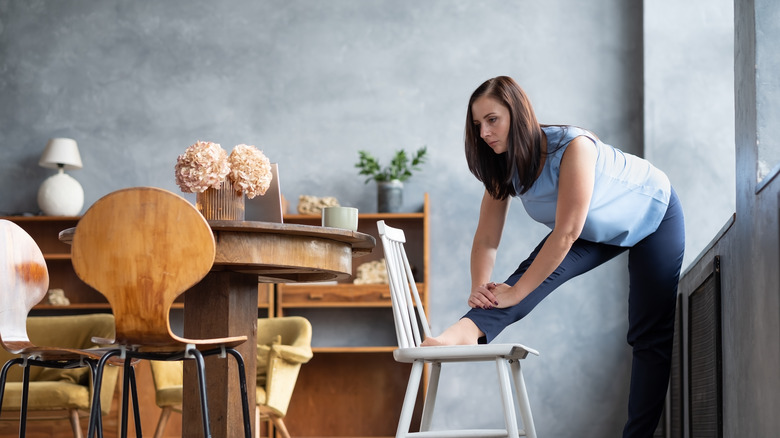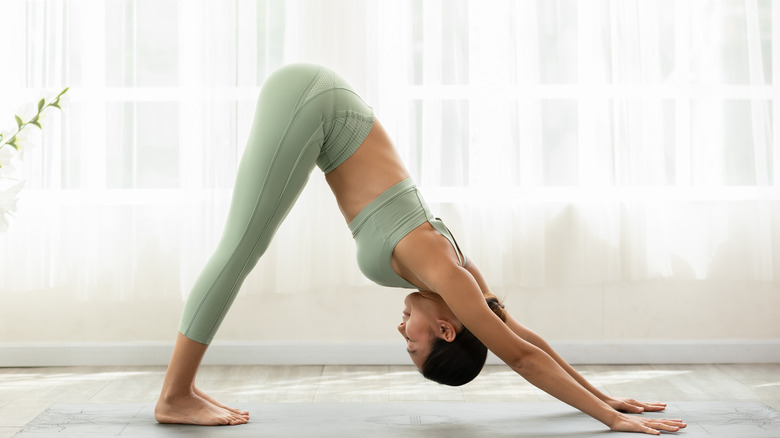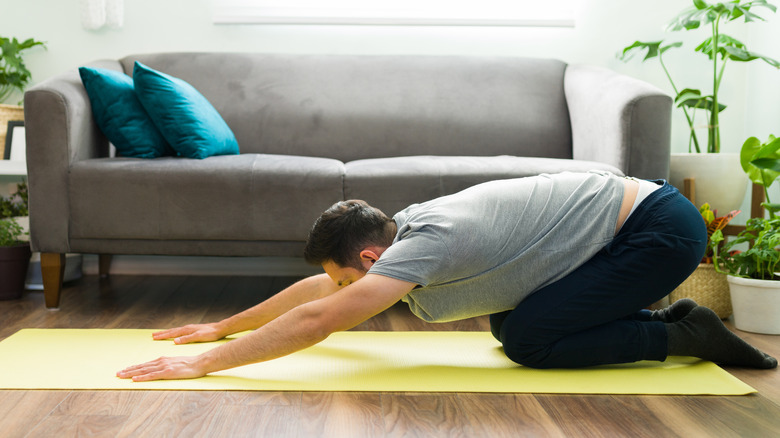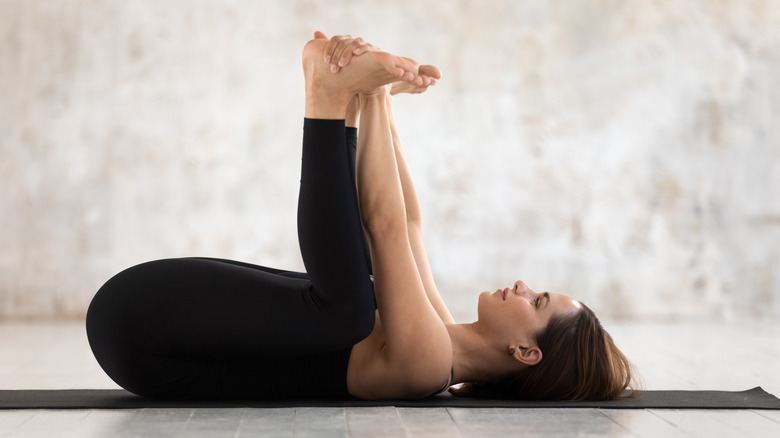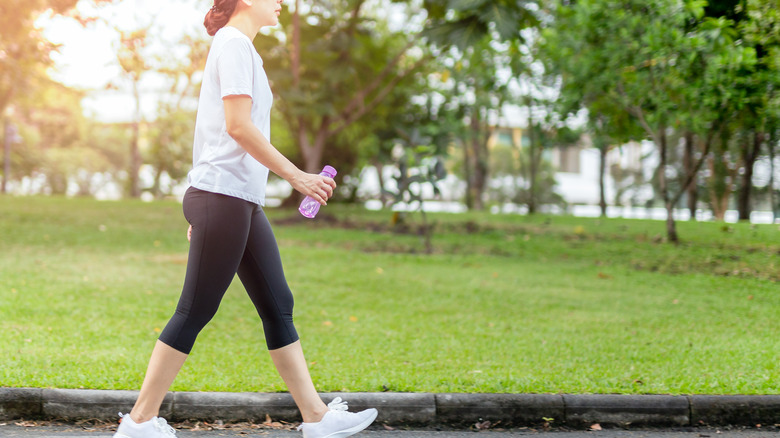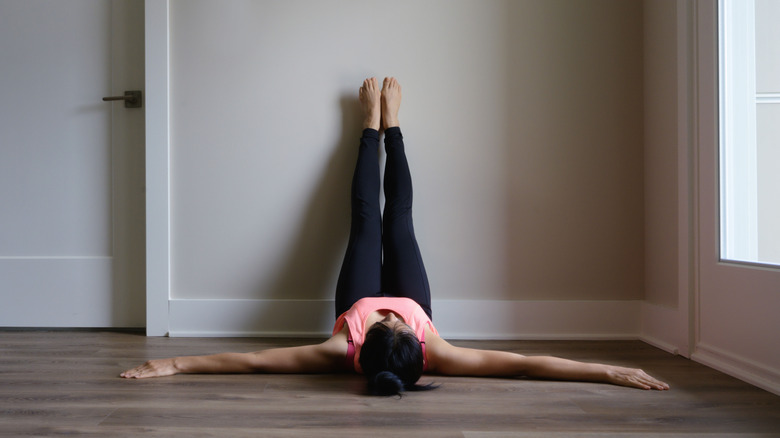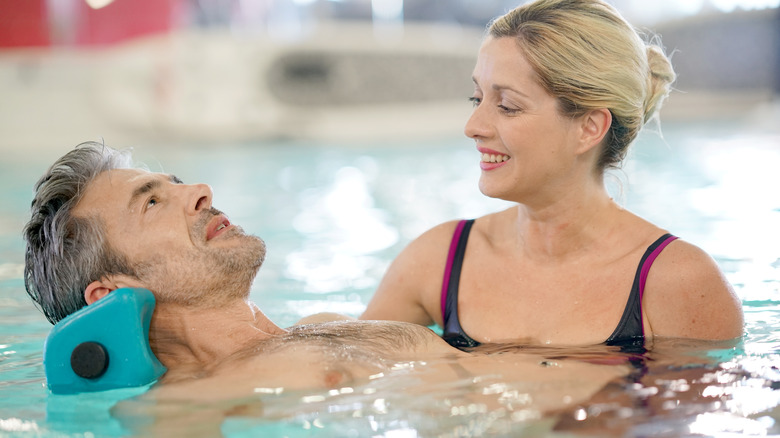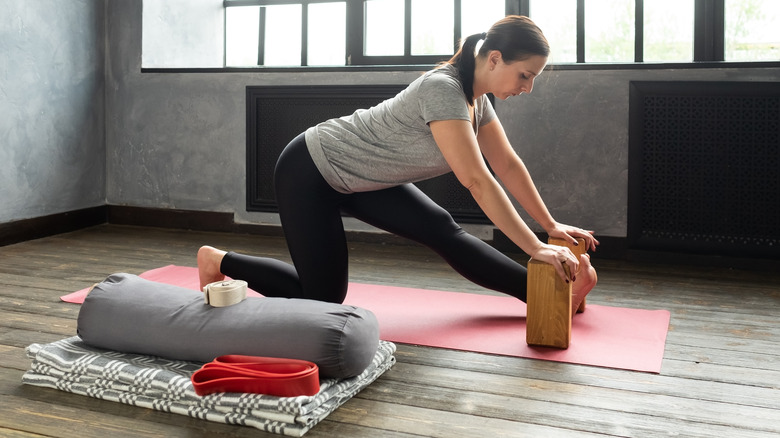The Best Exercises For Sciatica Pain
Sciatica is literally a pain in the butt! Any type of lower back pain can range from being a minor nuisance to debilitating (via WebMD). And when it's met with pain that extends from your lower back through your buttocks and to the back of either thigh, it's a condition known as Sciatica. "Up to 40% of all people will experience sciatica" (via Moreno Spine & Scoliosis). Some describe sciatic pain as sharp or throbbing, and it may also be felt as a burning sensation (via Yoga Journal). It may be worse when sitting, bending or twisting, or rising to stand. However, stretches, including yoga postures (asanas) may offer some relief.
Because it's the pressure along the (sciatic) nerve, which exacerbates sciatic pain, finding relief may be as simple as releasing the pressure (via NewSouth Neurospine). Both physical therapy and asanas have been shown to relieve sciatic pain. Gentle twisting can release pressure along the sciatic nerve, unless contraindicated by serious spinal defects or injury (such as a bulging or herniated disk). Exercises to loosen tight hamstrings may also help. But before practicing any program of yoga, stretching, or physical therapy, it is important to consult with a doctor; and it's always important to listen to your own body. Exercise should not be painful.
Incorporating Exercise for Sciatica Relief
It is important to seek the advice of your medical practitioner and physical therapist before taking on any form of exercise. This allows you to assess the root cause and avoid movement that could be contraindicative to your condition (via Spine Health). Besides physical therapy for strengthening specific muscle groups to alleviate pain, walking or non-weight bearing activities like swimming may be helpful (via Spine Universe).
A gentle yoga practice may help with sciatic pain, according to Centers for Spine and Orthopedics. A careful combination of yoga asanas (poses) along with slow, conscious breathing can provide relief. Specific asanas in a carefully constructed sequence can be beneficial so long as the practice is tailored to an individual's specific needs. Practice with ease, and be sure to exercise proper alignment to prevent injury (via Healthline). You should avoid any exercise that triggers or worsens your sciatic pain. Some yoga poses may be off limits due to any underlying condition or the extent of your pain. Since sciatic pain may vary, you will have to gauge how your body is feeling at any given time, a given day.
Knees to Chest
In yoga, Apanasana (knees to chest) is also known as "wind-relieving" — it brings the toxins downward and out of your body, according to Next Yoga. It is stabilizing for the pelvis, provides a gentle stretch for the lower back, and can release the pressure upon the sciatic nerve.
Taking pressure off your spine and pelvis may provide temporary relief from sciatica pain (via Yoga Journal). Start in a supine position (lying flat on your back). Slowly draw both feet onto the mat, knees pointing toward the ceiling. Then gently draw your knees toward your chest. Inhale as you gently release knees slightly away from your chest, then exhale as you hug them in (knees slightly splayed toward your armpits). Hold the pose for 30 seconds to one minute and inhale as you release. You can gently rock side to side or back and forth to explore the extent you can exercise with ease, while avoiding any strain.
Reclining Pigeon
The best stretches to alleviate sciatica pain include those that externally rotate the hip, according to Dr. Mark Kovacs, a certified strength and conditioning specialist, for Healthline. Stretching the hips, hamstrings, and piriformis muscle can help release the pressure on the sciatic nerve which causes the pain (via Spine Health). Reclining Pigeon Pose helps to open your hips and stretches the glutes and piriformis, a small muscle located behind the gluteus maximus, according to Spine Health.
Doing pigeon pose on your back supports your lower back and reduces the pressure on your hips (via Healthline). Start by lying on your back with your knees bent, feet on the floor, and ankles pointing toward your buttocks. Lift your right knee and gently place your right ankle on the bottom of your left thigh. For a deeper stretch, lift your left foot and draw your left knee toward your chest. Interlace your fingers to around your left thigh for support. Hold this pose for a minute. Then, repeat on the other side.
Cat-Cow
Cat-Cow is a yoga pose that can open your spine and release the tension in your lower back (via Premiere Health Chiropractic & Wellness). This pose works by gently stretching the spine, which allows the decompression of your vertebral discs. It also helps to strengthen the abdominal muscles and obliques for a stronger core. A stronger core can help support the lower back to prevent risk for back strain (Premier Spine Institute).
To practice this pose, start on all fours with your shoulders above your wrists, and your knees hip distance apart (via Heartline Fitness). Your head and spine should be parallel to the floor. Draw your belly to your spine to arch your back like a "scared cat," as you gently tuck your chin. Hold this position for as long as comfortable (or five to 10 seconds), according to Healthline — then return to the starting position. Lift your head up slightly as you raise your buttocks toward the ceiling (belly slightly drops) to form the "cow" position, and hold. Repeat the entire Cat-Cow sequence at least five times for best results (per Premiere Health Chiropractic & Wellness.)
Half Locust Pose
Locust Post is one of the best exercises for healing sciatica because it provides circulation to the hips while strengthening the lower back (and opening the chest), according to yoga expert Sarah Powers for Yoga Journal. Because this pose requires some back and abdominal strength, it can be challenging (via Yoga Journal). Half Locust Pose — which does not require a simultaneous lift of torso and legs — is a good option for beginners.
Start on your belly with your arms to your sides, palms facing down. Place your feet together and press your toes into the mat. Rotate your inner thighs to the ceiling (and gently press your hands into the mat) as you lift your chest and head. Focus on lengthening your spine to distribute space evenly between your vertebral discs as you roll back your shoulders and lift your sternum. Avoid crunching your lower back. Take a few breaths and slowly release.
Seated Spinal Twist
A tight piriformis can lead to deep pain in the buttocks and spasms (via Yoga International). It may also be accompanied by sciatica. A gentle spinal twist will allow your piriformis muscle to release and lengthen. The key is to take it slow and gradual, increasing intensity over time as you are able, because overworking the piriformis can be counterproductive.
Start sitting on the edge of a folded blanket — with your knees bent and feet on the floor in front of you. Place your right foot below your left knee and gently guide it toward your left hip. For the gentlest stretch keep the left foot rooted just below the right knee, in line with your left hip. For a deeper stretch, cross the left foot over your right knee. Balance the weight between both hips. Interlace your hands just below the left knee, and tug lightly to help lengthen your spine. Hold this pose for about 20 seconds. For the twist, if you are able, follow the 20-second hold (spine lengthened) with a gentle twist toward your upright knee before repeating on the other side.
Standing Hamstring Stretch
According to Healthline, tight hamstrings may result from sciatica. But tight hamstrings may also exacerbate the condition, as they increase stress on the lower back and put pressure on the sciatic nerve (via Spine Health). Regardless which comes first (tight hamstrings or your sciatica), you can ease your pain by loosening those hamstring muscles through this Standing Hamstring Stretch. If your hamstrings are tight, it may be difficult to straighten the knee and bend forward from the hip. Warming up with a 10-minute walk prior to stretching can improve blood flow circulation to the hamstrings and elicit better ease in performing this stretch.
This version of the Standing Hamstring Stretch uses a prop to elevate one leg (via Healthline). Place a stationary chair in front of you (or stand in front of an ottoman). Then, place one foot on top and flex it. Straighten your elevated leg as much as possible without strain. Gently crease your hips to lean forward. You should feel a gentle stretch in the back of your thigh (hamstrings). Hold for 30 seconds and repeat on the other side.
Downward Facing Dog
Practicing Downward Facing Dog can help align, lengthen, and strengthen your lower back (via Yoga International). It may also help loosen the hamstrings, according to Stephanie Mansour, certified trainer, yoga and pilates instructor, and health & fitness writer for Today. But, while it is helpful in managing sciatica, it should only be done if acute pain has subsided (via The Healthy Back Institute).
Mansour emphasizes that proper form should be executed, thus a beginner may want to start by using a wall to avoid improper alignment which can lead to strain. Bending the knees to allow hips to tilt forward can be helpful. Start by standing about three feet away from a wall. Place your hands on the wall at shoulder height, fingertips pointing up. Lean toward the wall (keeping your arms straight). Gently guide hips back as you lower your head and torso toward the floor. As you press into the wall and pull your hips back (knees bent as necessary), draw your belly toward your spine.
Another variation would be to start from all fours (tabletop position), according to Yoga Tree. Spread your palms flat and align your wrists below your shoulders with your knees directly below your hips. As you press into your hands, slowly raise knees off the mat as you press your stomach toward thighs. Lift hips high as you begin to straighten your legs (keep a bend in the knees to avoid strain). Press your heels toward the ground.
Child's Pose
Your everyday grind may be giving your back some grief, especially if you find yourself sedentary for long periods of time. Desk jobs may exacerbate back pain by compressing the spine, according to Comprehensive Spine & Pain.
Child's pose can help ease or prevent lower back pain by elongating and decompressing the vertebrate. And it is a simple way to relieve sciatica pain with a gentle forward motion — no twisting involved (via NewSouth NeuroSpine). Twisting may be contraindicated if you have a herniated disk or spinal injury. To get into Child's pose, kneel on all fours and place your hands in front of you, in line with your shoulders. Bring your toes together and widen your knees enough to gently hug your ribs. Sit back as you rest your hips on your heels. Draw your head toward the ground to lengthen your spine. You can rest it on a block or towel.
Happy Baby
Happy Baby pose is ideal for calming the mind and restoring your energy (via Greatist). And don't worry if it looks a bit silly, it can help remedy your sciatica woes. It not only releases a tight lower back, but also helps to loosen tight hips (via Pop Sugar). What's more, restorative poses may cut through the pain cycle as they may alter your perception of pain, according to Yoga Anytime. Consistency, with a focus on breath and surrender, makes restorative poses beneficial for sufferers of chronic pain.
Happy Baby is a gentle pose you can ease your way into, and it's practiced in both yoga and pilates (via Greatist). Start by lying flat on your back on a comfortable surface such as your mat. Bring your knees toward your chest, bottoms of feet facing the ceiling. Grab either the insides or outsides of your feet and gently spread your knees apart (wider than your armpits). Gently rock like a "happy baby" from side to side. You may stay in this pose for as long as you desire — to reap its revitalizing benefits.
Walking
When gentle twists, folds, and seated poses are a challenge, you may try walking instead. Walking helps promote blood flow in the body, which can make your nerves more resilient, according to Rahul Shah, orthopedic spine surgeon, for Spine Universe. He recommends starting with shorter walks to build stamina and prevent over-exerting tender areas. Shah points out that walking can either help or worsen sciatic pain. So, it is important to know your limits and listen to your body. It is not uncommon to need a break between walking a few blocks since for many with sciatica, the legs may get heavy, says Shah.
Implementing a regular walking routine, however, may benefit those with sciatica because it releases endorphins, which can reduce pain, and it reduces inflammation (via Spine-health). To prevent poor posture, which can exacerbate symptoms, take shorter strides to prevent compression of the spine. This will keep your pace slower and prevent injury. Engage your core to support your spine. Core support includes standing upright (no slouching), and gently drawing in the stomach toward the spine. Rhythmic breathing will support the effectiveness.
Legs Up the Wall
Legs Up the Wall is a restorative pose that stretches those tender areas affected by sciatica, including your hamstrings, glutes, hips, and lower back (via Yoga Journal). It also improves your circulation, according to Cleveland Clinic. Standing or sitting too long may compromise healthy blood flow, so this legs-up-the-wall pose can help move that blood along and can prevent any stiffness or lower-leg swelling.
A thin pillow may be helpful to support your head as you relax through this pose (per Cleveland Clinic). Start by placing your mat or blanket on the floor perpendicular to the wall. Lay down on the blanket and scoot your buttocks toward the wall (a few inches away). Extend your legs up the wall, with your knees slightly bent and feet flexed — forming an L-position. You should feel a gentle stretch without any strain. Focus on your breath as you ease and remain in this pose (for up to two to three minutes). Gently exit into a seated position. Note: If you don't want to scoot into this position, you can start by sitting with your right side against the wall, and then swing legs up while gently guiding your head and torso flat onto the mat (via Yoga Journal).
Swimming
Because water exercises are gentler on the joints, they are considered safe activities for those with back injuries and chronic pain (via Livestrong). They can provide relief from sciatica, while helping to strengthen the back muscles to support your spine.
Swimming is a low impact exercise you can incorporate into your physical therapy for sciatica (via Spine and Pain Clinics of North America). It helps flexibility and mobility without joint stress or the risk of falling. And it may be effective for releasing stress on the sciatic nerve for pain relief. For best results, you should perform strokes that keep your head and body in alignment, such as the side stroke. Strokes that require turning the head or arching the back may put pressure on the joints. Swim in slow and controlled movements to avoid overexertion. You may start by swimming two days per week and build up stamina over time.
Exercise Adjustments and Modifications
You may want to refrain from any physical exercise, including yoga, when in acute pain or severe disc herniation as rest may be necessary to reduce inflammation and prevent further damage (via Center for Spine and Orthopedics). But when you are ready to get in some movement — and have the thumbs up from your doctor or physical therapist — yoga can help with healing and preventing further pain. When done correctly, the gentle stretching of yoga benefits spinal alignment, strengthens supportive muscles, and releases tightness that can affect the sciatic nerve (i.e., tension in the piriformis muscle).
It is important to avoid any movement in which "shooting pain develops," cautions Sarah Powers, yoga expert and journalist for Yoga Journal. When in a seated forward bend, bring in one leg to the groin (on the side without sciatica pain) to avoid shooting pain in the lower back. If the pain is concentrated in the buttocks, draw in the leg where you experience pain. If shooting pain develops regardless of the adjustments, omit the pose. Powers suggests bending the knees in downward facing dog and any standing forward folds to ease pelvic rotation. Approach twists slowly and gently, or avoid altogether if it is contraindicative to your degree of injury, disease, or condition (via NewSouth NeuroSpine).
Additionally, yoga props may be helpful. Blocks, blankets, and pillows provide ease and support for poses that otherwise would not be possible due to injury and tightness (via Shantisom). A block will meet you halfway when you've got issues such as tight hamstrings — it can bring the ground closer to you to prevent strain. A rolled up blanket may also support by lifting your hips higher when in a seated position (asana). And you can use a pillow to support your head when in a restorative pose for improved comfort.


